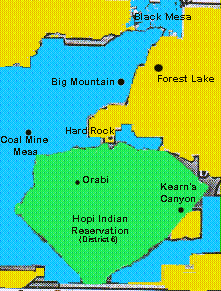GREGAIOUS VIOLATIONS OF HUMAN RIGHTS IN THE ADMINISTRATION OF JUSTICE ON HOPI PARTITIONED LAND IN SENATE BILL S. 1973, AND IN THE PROCEDURES USED TO DEVELOP & PROMOTE S.1973 VIOLATIONS WITHIN S. 1973
A Brief History of the Land dispute

What happens now?
Why don't the Big Mountain resistors want to sign the Accommodation Agreement?
Has the Hopi Tribal Council listened to the concerns of the Big Mountain resistors?
Where will they be relocated to?
Who will enforce the relocation?
No, this is a dispute between corporate interest and Native Heritage. In 1973, a public relations' team was hired by Peabody Coal Co. to fabricate "rang-war" between the traditional Hopi and Dineh people, who, had been living in harmony for over one hundred years. In order to avoid this so called "range-war" congress passed P.L. 93-531 in 1974. This law divided the joint we area into Hopi and Navajo partitioned lands, and the Hopi Tribal Counsel, in collusion with mining interests and the U.S. government, took control of the ancestral home of the Dineh Resisters.
*The Hopi and Navajo Tribal Councils do not necessarily represent traditional interests.
Return of the Black Hills(Next) | Mumia Abu-Jamal (Back)